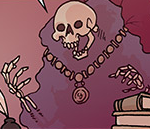|
Unfortunately I'm pretty sure 5E will never make a good video game(how could it, really, with...whatever it has that are called rules). a 4E Fire Emblem/Final Fantasy Tactics style type game I think is what we really needed for DnD to actually have real video game legs. It would still be kind of niche, but being as niche as Fire Emblem or FFT is a pretty decent place to be (especially compared to DnD video games right now). For now we'll just have to take Pillars of Eternity, which does use a lot of 4E ideas, and I liked that game quite a lot, so I guess I'm half alright with the current state of affairs? Still would have bought like a 200$ collectors edition of a for reals good 4E game, but I'll take what I can get I suppose.
|
|
|
|

|
| # ? May 13, 2024 19:40 |
|
The best 4E video game is the Firaxis XCOM reboot.
|
|
|
|
Kai Tave posted:The best 4E video game is the Firaxis XCOM reboot. Tangentially related to 5ed, I picked up Shadow of the Demonlord, which was kickstarted and written by one of the 5ed guys. Granted, the mood and tone is something I'm a total fanboy for, but has anyone played it? How does it compare to 5ed and Flame Princess? Any outstanding novel mechanics I should look out for while reading? How are the expansions? Another thing that's been bugging me. Why are pdfs often 32 pages? Pathfinder does that consistently and so do other companies. Did someone work out an equation for optimal printing costs?
|
|
|
|
Helical Nightmares posted:
One of the few enemies from early 4E which got outright errata was Needlefang Drake swarms which were supposed to be early low-level enemies (appearing in Keep on the Shadowfell most notably) and were absolutely murderous to the point where there were numerous tales of sessions where half the party died or a TPK ensued because they got eaten by swarms of piranha-lizards.
|
|
|
|
Helical Nightmares posted:
Printing is typical done in a way where for mass market 32 pages is the minimum number that will get a printer to give you a quote, and then it runs in multiples of 16 pages past that. It doesn't really have anything to do with cost anymore, it's just the way things are done. Honestly with POD you could run any set of numbers cost effectively, but your binders will have a fit unless you do things in multiples of 16 pages because that's what they're used to.
|
|
|
|
Western CRPGs suck rear end.
|
|
|
|
Helical Nightmares posted:Granted, the mood and tone is something I'm a total fanboy for, but has anyone played it? How does it compare to 5ed and Flame Princess? Any outstanding novel mechanics I should look out for while reading? How are the expansions? That's a very good question. Please provide a trip report, tia.
|
|
|
|
Kwyndig posted:Printing is typical done in a way where for mass market 32 pages is the minimum number that will get a printer to give you a quote, and then it runs in multiples of 16 pages past that. It doesn't really have anything to do with cost anymore, it's just the way things are done. Interesting. Thanks!
|
|
|
|
Note: This is also why books will have blank pages at the beginning or end, if you count out all the pages in the book including the blank ones? Multiple of 16.
|
|
|
|
I've been having a hankering for Mordheim lately. Did the computer game turn out to be any good?
|
|
|
|
I was thinking about sandboxes and 4x games. Found the following review for the video game Polaris Sector (which I have not played) and I liked the analysis. http://explorminate.net/2016/03/22/polaris-sector-review/ quote:Polaris Sector Review And there is more.
|
|
|
|
So this might be a stupid question, but I'm going to ask it anyway: I've had some fairly good success scheduling weekly TRPG games with you good folk on the internet, and it got me thinking about doing the same but for video games. Like, let's play a game of compstomp Age of Empires at this time and day, or lets meet every week for 2 hours to slowly work through an RPG cooperatively. It never really occurred to me, but does that make sense? Am I just overthinking this?
|
|
|
gradenko_2000 posted:So this might be a stupid question, but I'm going to ask it anyway: Goons have been doing this successfully for weekly Europa Universalis 4 for ages, I don't see why you couldn't do this for basically any other game either. I'm just now getting on this whole Discord thing, would that make it easier? Or maybe just ask people in the #badwrongfun ?
|
|
|
|
|
So I've been thinking about putting together a little "core" packet of a few of the various D&D systems. Basically my goal is to have a list or collection of books for each edition that is the most "complete" and least "broken and bloated" as possible for that edition, that I can point to and say, "for the best and most complete experience with <edition>, use those books". Yes I know that invariably all D&D editions have been broken and bloated at some point, I just want to be able to distill it down. What would they be for 2e/Pathfinder/4e? I never played 2e and have no experience with it beyond the Baldur's Gate games, but I would assume that the Core 3 rulebooks (PHB, MM, DMG) would be where it's at, though that leaves out a lot of the extra campaign settings/etc that give 2e its flavor. For Pathfinder and 4e I'm a lot more unsure. 4e has like five books called Player Handbook, let alone the various other class supplements/etc. And Pathfinder just seems like a wasteland of scattered material unless you just use the SRD.
|
|
|
|
|
4E: Rules Compendium for the core rules with all errata bakes in, and Monster Vault for iconic monsters with good math and design. Character options is where it gets a bit tricky. If you get the offline character builder, CBLoader and custom files, you can have every option ever published in one place, but that's the opposite of "least bloated." You can uncheck certain sources in the CB though, which still makes it a good thing to have. As for the sources themselves, I'd go PHB 1/2/3 and the various ____ Power books. More basic, go PHBs only, super core basic would be PHB 1/2. That's my idea of the core of 4E; Essentials (Heroes of the Fallen Lands and all that stuff) sounds like it would be it but it's design muddles what I like about 4E too much. For my current 4E game I did: - PHB 1/2/3 - all _____ Power - all Adventurer's Vault - all races and classes from Eberron, Dark Sun and Forgotten Realms, plus feats and items that have them as a prerequisite In retrospect, I'd ditch Adventurer's Vault from this setup. They only add items and good lord does 4E have too many items.
|
|
|
|
Drone posted:For Pathfinder and 4e I'm a lot more unsure. 4e has like five books called Player Handbook, let alone the various other class supplements/etc. And Pathfinder just seems like a wasteland of scattered material unless you just use the SRD. It's been a long time since I Pathfound, but I would say the core book, all the official bestiaries, and whatever that supplement was that added the inquisitor, witch, gunslinger, etc. It's been even longer since I AD&Ded, but you're probably fine with PHB, DMG, MM, and the Psionics Handbook (which is necessary to fully use some of the creatures in the MM). If you're running in a pre-existing campaign setting, get the core box set for your setting of choice.
|
|
|
My Lovely Horse posted:4E: Rules Compendium for the core rules with all errata bakes in, and Monster Vault for iconic monsters with good math and design. Character options is where it gets a bit tricky. By "all ____ Power", you mean the sequels too I assume, right? Googling it, there are apparently multiple Martial Power books for instance. (Also fuuuuuck, used 4e books are dirt cheap on Amazon.de) I wasn't on board the 4e train back when it was a current edition, but isn't the Rules Compendium that you mentioned part of that controversial Essentials line?
|
|
|
|
|
I guess! I honestly haven't looked at the Power books specifically, it's more that nothing from them ever struck me as badly designed, and they add a few neat character options (like an Archer Warlord). It really depends a bit on how you present the sources: if you want to hand players books you're better off sticking to PHBs only before you whomp a whole stack on the table, if you're using the builder, might as well chuck 'em in. You can run a perfectly good game and build a perfectly good character with PHB options only, so if maximum unbloatidity is your goal, stick to the PHBs. Rules Compendium and Monster Vault are part of Essentials but everything that makes me dislike the line is contained within class design and items, and those books don't have any of that. Plus, most of the errata to the basic rules were extremely necessary, and like I said, the RC has them baked in. Same with Monster Vault - most monsters before MM3 weren't very well designed and had flawed numbers, and Monster Vault fixes that for a bunch of basic and iconic creatures.
|
|
|
|
A "best-of" collection of 4th Edition would include, at the minimum: Player's Handbook 1 - all the basics Player's Handbook 2 - the new armors introduced here are necessary for proper gear scaling, and the new classes are very good Monster Vault - has all of the iconic monsters and with a comprehensive level spread, but with the corrected monster math from Monster Manual 3 It gets a little bit more complicated after that. Dungeon Master's Guide 1 has great advice for running and managing games (any TRPG really, not even just D&D), but all of the mechanical stuff is out of date and needs to be disregarded. The DMG 2 also has some excellent adventure plotting advice (written by Robin D Laws of Pelgrane Press no less), but again you can't use most of its rules directly. Essentials Dungeon Master's Kit OR Rules Compendium has the updated mechanics rules like reasonable skill check DCs, and the easier to use, randomly-rolled treasure system, but its all dry mechanics and doesn't have the practical advice that DMGs 1 and 2 have. The advantage of the Essentials Dungeon Master's Kit specifically is that it also comes with the Reavers of Harkenwold adventure, which I'll get into later. The advantage of the Rules Compendium is that it's cheaper since it specifically only covers rules. The Dark Sun Campaign Setting book has the rules for Inherent Bonuses, which I'd consider critical to ensure that players are never screwed over on their gear. Player's Handbook 3 has the Versatile Expertise feat, which is a critical feat tax. Heroes of the Fallen Lands OR Heroes of the Forgotten Kingdoms has the Improved Defenses feat, which is a critical feat tax; they also have Expertise feats for specific weapons, as well as the Melee Training feat, which is a critical feat tax for several builds. Technically, those books in the preceding paragraph aren't necessary if you're going to use the 1-2 pages in them for the feats and inherent bonus rules and nothing else, but that's the specific reference. For adventures, you're going to want to do a cycle of: 1. The Slaying Stone 2. The Reavers of Harkenwold (which comes with the Essentials Dungeon Master's Kit, which is why the Kit is an option over just the Rules Compendium) 3. The Cairn of the Winter King 4. Madness at Gardmore Abbey That will take characters from level 1 all the way to level 8, which is arguably the sweet spot of the system, and while using the best-written adventures of the lot.
|
|
|
|
The DM's Kit doesn't contain all the rules, I think, and it's poorly indexed to boot.
|
|
|
|
There's no reason not to get the Rules Compendium, and there's no reason to get PHB1 for the rules.
|
|
|
|
I really wish we had gotten books like "complete martal" for 4e that had all the martial classes and class specific feats oh also race books other than dragonborn
|
|
|
|
At the bare minimum, you still need the PHB 1 for the equipment lists, which aren't duplicated anywhere else except in the Heroes of ... Essentials PHBs.
|
|
|
|
Now I get why they made all of these resources just available on the D&D Insider subscription thingie. I want to like 4e real bad but I feel this version in particular has tons of "go to this book for this specific thing but do not use that book for <this specific thing>, instead borrow elements from these two other books" Like, "please do not use the Player's Handbook as if it were a Player's Handbook, use this other thing!"
|
|
|
|
|
Yeah. In practice, it boils down to "buy the Rules Compendium and Monster Vault and use the offline character builder so you have all the player options in one location," thanks to Insider + fan support.
|
|
|
|
Yeah as a DM I just use the Rules Compendium and the Monster Vault, and leave the players to create their characters however they want.
|
|
|
|
For Pathfinder would you throw in Ultimate Campaign into the core or not.
|
|
|
|
Drone posted:Now I get why they made all of these resources just available on the D&D Insider subscription thingie. I want to like 4e real bad but I feel this version in particular has tons of "go to this book for this specific thing but do not use that book for <this specific thing>, instead borrow elements from these two other books" e: I have to say, Monster Vault gets pretty barren once you hit epic levels.
|
|
|
|
My Lovely Horse posted:e: I have to say, Monster Vault gets pretty barren once you hit epic levels. I am not entirely sure, myself, that normal monster-building guidelines are sufficient to challenge an Epic Tier party. I mean, the math is pretty okay, but you need to get downright creative to challenge them.
|
|
|
|
dwarf74 posted:I am not entirely sure, myself, that normal monster-building guidelines are sufficient to challenge an Epic Tier party. I mean, the math is pretty okay, but you need to get downright creative to challenge them. Yeah, you'd have to crank up the damage to something like a [5d12+16] danage at-will for a level 25, whereas an MM3 level Drow Archmage has an at-will for [4d8+15]. And even then you'd still have to be creative insofar as getting past all the interrupts and triggers anyway.
|
|
|
|
There's a reason why Epic Level D&D never really works out, either the PC's end up too strong and clown everything effortlessly, or you end up with ridiculous overpowered enemies that no sane party could reasonably beat(like Neutronium Golems)
|
|
|
|
For 4E in particular you can add to the list that if you do manage to balance everything right, your combats will take hours and with all the interrupts and triggers you'll lose track of whose turn it is. I prefer playing in a good level range and reflavouring the setting and enemies to be as epic as you like. Be a royal army squad on special assignment at level 15, be legendary heroes out for one last hurrah at level 2, it's all in how you play and contextualize it. My Lovely Horse fucked around with this message at 07:02 on Apr 7, 2016 |
|
|
|
drrockso20 posted:There's a reason why Epic Level D&D never really works out, either the PC's end up too strong and clown everything effortlessly, or you end up with ridiculous overpowered enemies that no sane party could reasonably beat(like Neutronium Golems)
|
|
|
|
Is anyone here entering the 200 word RPG challenge?
|
|
|
|
There's been some discussion of it over in the Games Writing thread. I threw together a thing myself: https://docs.google.com/document/d/1rw4SJGpYNNOV1eQPFBugTmUnqsfQSe7l2blbZ7zB7nk/edit?usp=sharing
|
|
|
|
That's 200 too many.
|
|
|
|
chaos rhames posted:Is anyone here entering the 200 word RPG challenge?
|
|
|
|
I'd really like to if I can think of a drat thing.
|
|
|
|
Questions for the Roll20 users among you: How normal is it to use it without video? And how about without video or audio, just communicating in the text chat? (I'm investigating gaming options, and right now I own neither webcam nor microphone.)
|
|
|
|

|
| # ? May 13, 2024 19:40 |
|
potatocubed posted:Questions for the Roll20 users among you: How normal is it to use it without video? And how about without video or audio, just communicating in the text chat? I've run all my games through roll20, and I've only had the webcam activated once, and only because the other users had it on. Every other time has been just through audio. I tried running games through text chat, and it's a lot slower and I'd avoid it unless my only other option was PbP.
|
|
|





























